Called Double Asteroid Redirection Test (Dart), the mission, also described in Science magazine, will depart tomorrow (November 24) from Vandenberg Space Force Base, California.
With a budget of approximately 325 million dollars, it will aim to evaluate the feasibility of the strategy of
deviation of potentially dangerous asteroids
.
In fact, the Dart target does not represent a danger to the Earth, but the mission is preparatory for a future stabilization of a planetary defense program.
The impact of an asteroid on Earth 66 million years ago caused the end of the dinosaur era.
NASA has cataloged over 90 percent of these
large racing cars
, which travel into space close to our planet, showing that there do not seem to be any signs of risk in the coming centuries.
However, even asteroids of a few hundred meters can cause problems, the experts point out, so it is necessary to be able to count on a defense program capable of overcoming these possible accidents. "An asteroid of
160 meters in diameter
- observes Elena Adams, scientist planetary at Johns Hopkins University and a system engineer on the Dart mission - could wreak havoc on a city like Manhattan. "
Over the years, several methods have been proposed to deal with the asteroid threat, from lasers to exploiting gravitational pull to divert their course to a nuclear bomb explosion.
Dart aims to hit the object to change its orbit.
After launch, the probe will travel for about
10 months
towards the pair of asteroids Didymos and Dimorphos.
The former is about 780 meters in diameter, but Dart is headed for
Dimorphos
, which measures about 170 meters in diameter.
The probe will use the Roll Out Solar Array (Pink), a flexible and rollable photovoltaic system, to collect the solar energy necessary for the electric propulsion system.
About ten days before reaching its goal, the spaceship will deploy
Liciacube
a small CubeSat, that is, the size and dimensions of a shoebox.
A satellite built by the Italian Space Agency, which will have the task of
following and recording the collision event
, which will occur at a speed of about 6 kilometers per second, 21,600 km per hour, 10 times faster than a fighter jet .
The images obtained by Liciacube will allow analysts to study the plume and the crater resulting from the impact.
The Hera mission of the
European Space Agency
should also collect information on the outcome of the mission.
Hera will carry an altimeter, several cameras and two more CubeSats.
"Dart is very different from the typical scientific missions - comments Adams - the main objective is not in fact linked to the acquisition of information, but to the identification of
potential techniques to save the world
".

